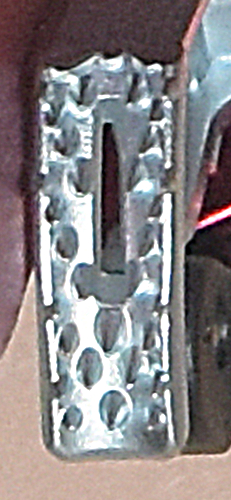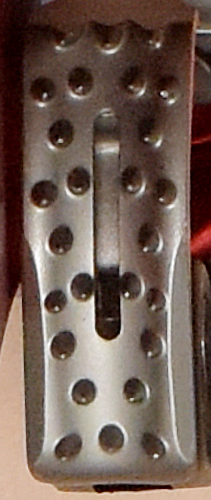Overview
[ Top
| Ascension
| Return to E.C. Ascenders
]
Basichold
(#3406)
Technical Details
I acquired my Camnal Basichold from Strade FarEast Ltd. (eBay seller 3cdeal_sfc) in 2021.
The Camnal Basichold is 111 mm. tall, 71 mm. wide, 25 mm. thick, and weighs 125 g. Like most handleless eccentric cam ascenders, the Fort
is right-handed.
 The ascender shell is subtriangular red anodized shape bent
from 3.0 mm. aluminum sheet. The rope channel is formed by
bending the left side of the ascender into a U. The rope
channel is 15 mm. wide. The main sling attachment
point is a 32 mm. wide, 17 mm. high D-shaped hole located below the cam
and to the right of the rope channel. There is an upper attachment
point above the cam, passing through both sides of the rope channel.
The upper opening is oval, 18.2 mm. high, and 15.5 mm.
wide. The right side of the shell is bent on an inclined axis
to form another U. This U is stamped with reinforcing ribs, and the top is turned inward, providing more reinforcement. A hole drilled through both sides of the U
accepts a standard rivet. The cam and cam spring are mounted on this
rivet. The pivot
is centered 45 mm. from the inside of the rope channel. There
is a small stamped cam stop that actually touches the cam.
The ascender shell is subtriangular red anodized shape bent
from 3.0 mm. aluminum sheet. The rope channel is formed by
bending the left side of the ascender into a U. The rope
channel is 15 mm. wide. The main sling attachment
point is a 32 mm. wide, 17 mm. high D-shaped hole located below the cam
and to the right of the rope channel. There is an upper attachment
point above the cam, passing through both sides of the rope channel.
The upper opening is oval, 18.2 mm. high, and 15.5 mm.
wide. The right side of the shell is bent on an inclined axis
to form another U. This U is stamped with reinforcing ribs, and the top is turned inward, providing more reinforcement. A hole drilled through both sides of the U
accepts a standard rivet. The cam and cam spring are mounted on this
rivet. The pivot
is centered 45 mm. from the inside of the rope channel. There
is a small stamped cam stop that actually touches the cam.
The cam is a plated skeletonized steel casting. The cam radius,
measured from the pivot, increases from 39 to 56 mm. over an angle of 34°, giving a 31° cam angle. The cam has number
of small conical teeth, all of which have their axes approximately
aligned with the cam pivot. The tooth pattern is (3.4)(1S1)^2(2S2)(1S1^2)(2.3.4.3) where the S stands for a single vertical slot. A spring-loaded plastic safety
is mounted on an axle riveted to the bottom of the cam.
The normal action of the spring holds the safety against the cam.
When the cam is opened, the shell interferes
with the safety tab, thus preventing opening the cam. At full
open the safety can be released and the spring will hold the tab
against the back of the shell, locking the cam open.
The front of the ascender is printed with an up-pointing arrow with "UP" inside, the Camnal logo, "Camnal," and "BASICHOLD." The rear is printed with he Camnal logo, "Camnal," "CE," "1019", "EN357:2013," "Ø8-13mm," "EN12841:2006-B," "• Ø10-13mm 100KG," and a book-with-an-"i" icon.
This is a nicely-made ascender. The top of the cam support is turned inward, giving a rounded form that is more comfortable than the abrupt edge found on most stamped hand ascenders. This is offset by the wide attachment hole at the base, whose edge tends to dig into my hands.
As commonly seen, a carabiner through the upper attachment holes will drag on the rope.
The Camnal Basichold is essentially the same as the Fort and S.E.Peak SA–206.
[ Top
| Basichold
| Return to E.C. Ascenders
]
Ascension
(#3476)
Technical Details
I acquired my Camnal Basichold from eBay seller Bosity in 2021.
 This Camnal Ascension is 110 mm. tall, 70 mm. wide, 26 mm. thick, and weighs 133 g.
This Camnal Ascension is 110 mm. tall, 70 mm. wide, 26 mm. thick, and weighs 133 g.
The Ascension uses the same shell as the Basichold, except there is no stamped cam stop.
The Camnal Ascension is 110 mm. tall, 70 mm. wide, 26 mm. thick, and weighs 133 g. The rope channel is 14 mm. wide. The cam axle is centered 43 mm. from the inside of the rope channel. The cam radius increases from 36 to 52 mm. over an angle of 37°, giving a 29° cam angle. The tooth pattern is (3.4)(1S1.2S2)^2(1S1.2.3).
The cam is a plated skeletonized steel casting of the drooped design. The cam radius,
measured from the pivot, increases from 36 to 52 mm. over an angle of 37°, giving a 29° cam angle. The cam has number
of small conical teeth, all of which have their axes approximately
aligned with a point five or six millimeters below the centerline of the the cam pivot. The tooth pattern is (3.4)(1S1.2S2)^2(1S1.2.3) where the S stands for a single vertical slot. A spring-loaded plastic safety
is mounted on an axle riveted to the bottom of the cam.
The normal action of the spring holds the safety against the cam.
When the cam is opened, the shell interferes
with the safety tab, thus preventing opening the cam. At full
open the safety can be released and the spring will hold the tab
against the back of the shell, locking the cam open.
The front of the rope channel is stamped with an up-pointing arrow with "UP" and "ASCENSION" inside. The inside of the shell is stamped with a book-with-an-"i" icon. The rear is printed with he Camnal logo, "Camnal," "CE EN357:2013," "ROPE • Ø10-13mm MAX 150KG," another book-with-an-"i" icon, "MADE IN CHINA", "CA", and "21090008."
The user is not likely to notice much difference between this Ascension and the Basichold. A cam stop serves no useful purpose outside of arbitrary strength testing, so I don't miss its being removed from the Ascension. The new cam is well-made. Despite the drooped design, which looks less rigid, it is rigid and functions just as well as more standard cams.
[ Top
| Basichold
| Ascension
]


